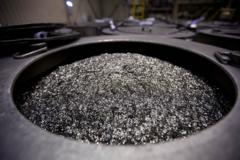Following the imposition of tariffs by the U.S., China has limited the export of essential rare earth minerals, significantly impacting American production capabilities in high-tech and defense sectors. This move underscores the urgent need for the U.S. to diversify its supply chains amid rising tensions between the two nations.
China's Rare Earth Export Controls: A Strategic Leverage in US-China Relations

China's Rare Earth Export Controls: A Strategic Leverage in US-China Relations
China's recent export restrictions on rare earth minerals are intensifying the trade war and spotlighting U.S. dependency on these critical resources.
As the escalating trade war between China and the U.S. continues to evolve, a new tactical move by Beijing has drawn attention: the imposition of export regulations on critical rare earth minerals. These minerals are essential for a variety of high-tech goods, raising significant concerns about American dependency on these imports.
This week, President Trump responded to these developments by instructing the Commerce Department to devise strategies aimed at boosting domestic production of these critical minerals. This marks a crucial shift in U.S. policy, as Washington seeks to augment its self-sufficiency and diminish reliance on foreign sources amid rising geopolitical tensions.
Rare earths are a collection of 17 chemically similar elements integral to the manufacturing of an array of high-tech products, including electronics, EV motors, and key military hardware such as missiles and radar systems. Although these elements are abundant, their extraction process is complicated and often hazardous, making them notoriously difficult to produce sustainably.
China currently wields considerable power in this market, producing approximately 61% of the world’s rare earth output and refining an astonishing 92% of it. This dominance is not a mere byproduct of a fortunate mineral abundance; instead, it reflects decades of calculated policy and investment by the Chinese government aimed at developing its mining and refining capabilities with less stringent environmental standards than those in many other countries.
In retaliation to U.S. tariffs, China has recently enforced new restrictions on the export of seven crucial minerals, particularly heavy rare earths, which are pivotal for military applications. From April 4 onwards, all exporters must obtain special licenses to ship these resources out of China, thus raising the stakes in the ongoing trade conflict.
A report by the U.S. Geological Survey highlights an alarming statistic: between 2020 and 2023, the U.S. sourced approximately 70% of its rare earth metals and compounds from China. This puts Washington in a precarious position since heavy rare earths are vital for advanced military technologies, potentially leaving the U.S. vulnerable to supply shortages that could significantly hinder its defense capabilities.
These restrictions could severely impact U.S. manufacturing sectors, which are already grappling with inventory challenges and rising costs of critical components that depend on these minerals. As the situation escalates, it may prompt a reassessment of U.S. supply chains and an effort to enhance domestic production, although achieving this will require noteworthy investments and advancements in technology.
Historically, the U.S. was once the leading producer of rare earths, but has since lost its competitive edge, largely due to China's aggressive market strategies. To curtail its dependency, the U.S. may explore mineral deals with other nations, including Ukraine and Greenland, which is home to substantial rare earth reserves.
The complicated relationship between the U.S. and China continues to evolve, revealing a dual challenge for America: The need to mend ties with China to secure a stable supply of critical minerals while simultaneously finding alternative partners. The pathway forward remains unclear as political tensions continue to unfold, with implications for both national security and economic resilience.





















